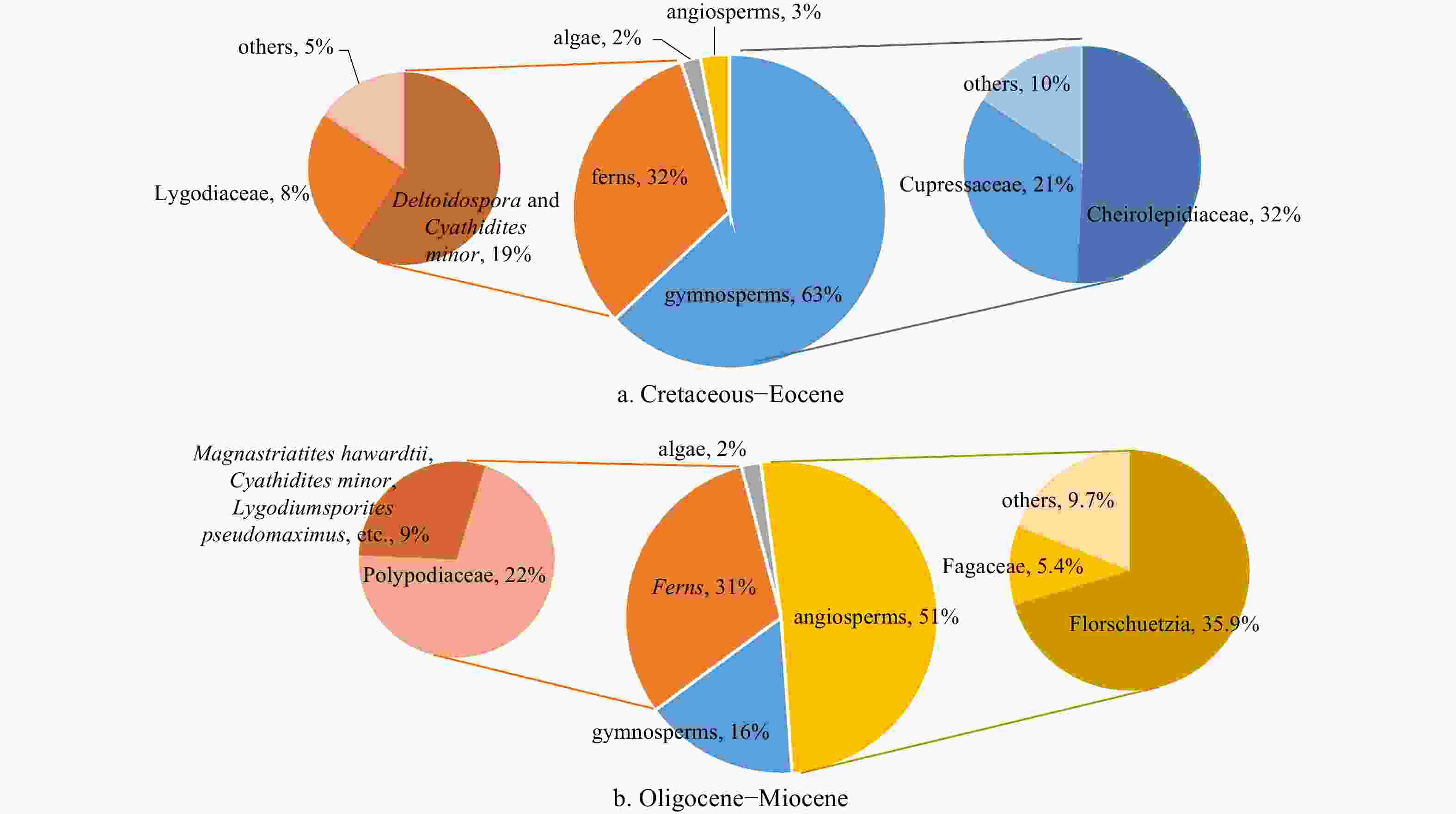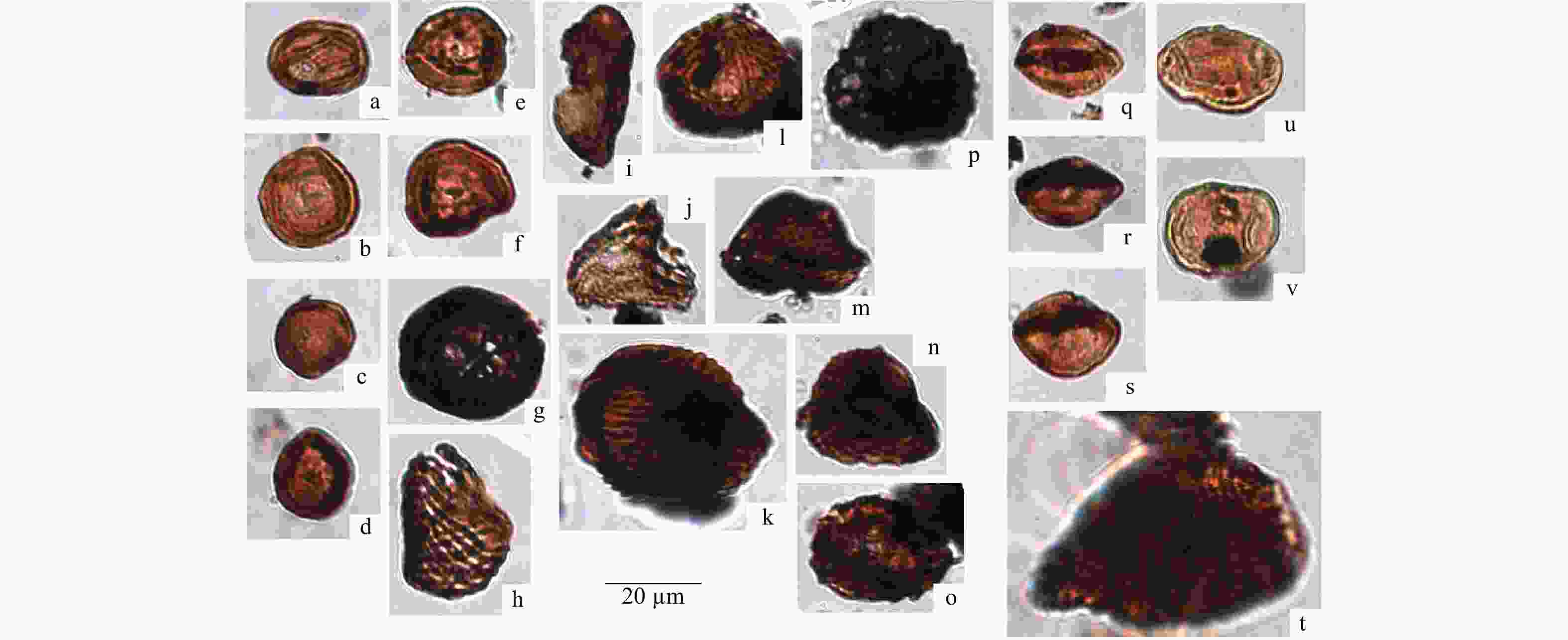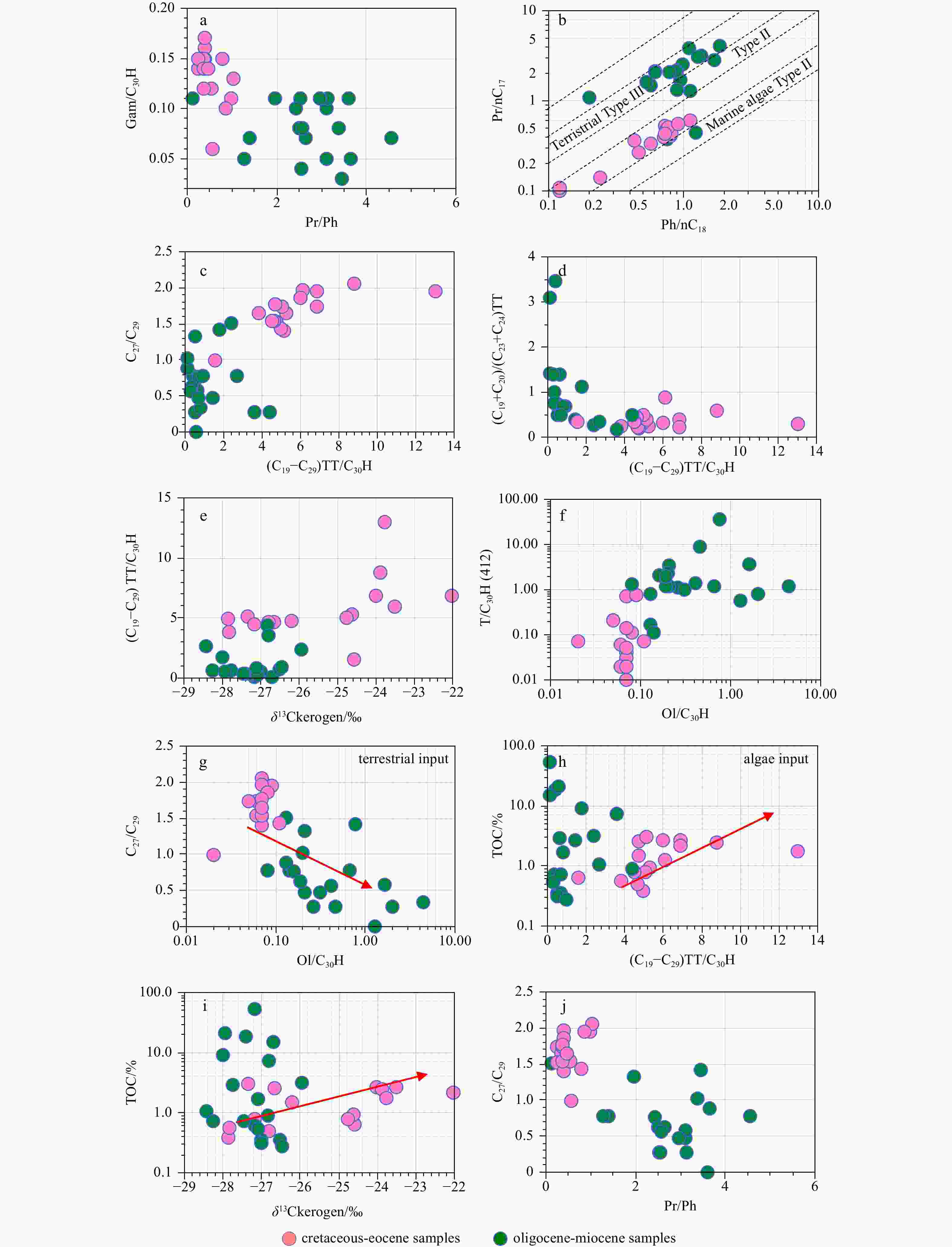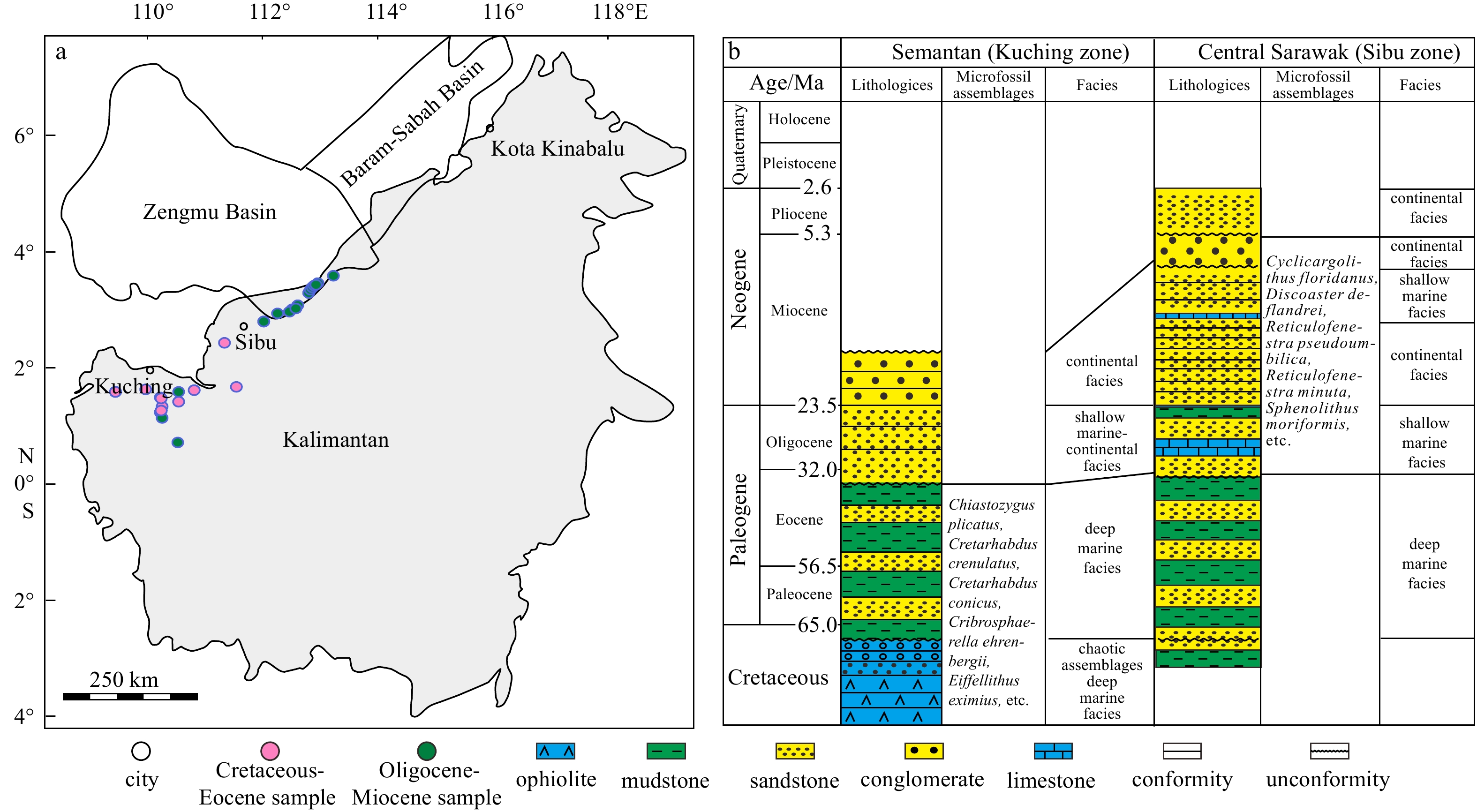The influence of organic sources and environments on source rock deposition during the periods of Cretaceous–Eocene and Oligocene–Miocene, northern Kalimantan
-
Abstract: The sedimentary system of Kalimantan has undergone significant development since the Oligocene. Previous research have largely ignored the capacity of the Cretaceous–Eocene sediments to produce hydrocarbons, focusing instead primarily on the Oligocene–Miocene coal as the principal source rocks. Shales and coals from the outcrops in the northern margin of Kalimantan were analyzed with palynological and geochemical methods to characterize the palaeoenvironmental and palaeoecological differences between the Cretaceous–Eocene and the Oligocene–Miocene samples. The high proportion of Cheirolepidoaceae, Schizaeoisporites and Ephedripites in the pollen assemblage from the Cretaceous–Eocene outcrops reflects an arid tropical/subtropical climate. The relatively low abundances of gymnosperm-derived biomarkers including isopimarane, β-phyllocladane, β-kaurane, suggest the gymnosperm features in flora. High C27/C29 ααα 20R sterane ratios, (C19–C29) tricyclic terpanes/C30 αβ hopane and extremely low oleanane/C30 αβ hopane, bicadinane T/C30 αβ hopane, and diterpenoid abundance indicate that there was a dominance of algae relative to higher plants in the organic matter. The gymnosperm-derived biomarkers, including isopimarane, β-phyllocladane, β-kaurane, suggest that palaeovegetation during this period was dominated by gymnosperms. The saline and reducing conditions in the bathyal and abysmal sea, evidenced by rather low Pr/Ph and high Gammarerane index, are beneficial for the preservation of hydrogen-rich organic matter. It is presumed that the Cretaceous–Eocene shales had great hydrocarbon generation potential in the southern South China Sea. During the period of Oligocene to Miocene in the Zengmu Basin and the Baram-Sabah Basin, the climate changed to a dominant humid and warm condition, which is corroborated by abundant pollen of Florschuetzia and Magnastriatites hawardi. Low C27/C29 ααα 20R sterane ratios, (C19–C29) tricyclic terpanes/C30 αβ hopane, and high oleanane/C30 αβ hopane, bicadinane T/C30 αβ hopane suggest that the palaeovegetation was dominated by angiosperms including the mangrove plants. The extremely abundant higher plants provide ample terrigenous organic matter for the formation of coal-measures in delta facies. The low gammacerane index and high Pr/Ph indicate the fresh and sub-oxic water in delta-neritic-abysmal faces, which is not beneficial for the accumulation of hydrogen-rich organic matter. Thus, the Oligocene–Miocene marine argillaceous rocks can be potential sources of natural gas.
-
Key words:
- biomarkers /
- source rocks /
- palynological records /
- palaeoclimate /
- South China Sea
-
Figure 1. Locations of the outcrop samples in Kalimantan (a) and the generalized stratigraphic column of the Sarawak area (b) (modified after Wang et al. (2016)).
Figure 2. Main calcareous nannofossils detected in K12 (a–d) and Q14 (e–h) samples. a. Cretarhabdus crenulatus; b. Cretarhabdus conicus; c. Cribrosphaerella ehrenbergii; d. Chiastozygus plicatus; e. Cyclicargolithus floridanus; f. Discoaster deflandrei; g. Reticulofenestra minuta; h. Sphenolithus moriformis.
Figure 5. The m/z 123 mass chromatograms and the parent-daughter m/z 274−123 transition of representative samples from the Cretaceous–Eocene (a) and the Oligocene–Miocene (b), showing the distributions of diterpanes. 1: β-labdane; 2: 19-norisopimarane; 3: 18-norisopimarane; 4: rimuane; 5: 17-nortetracyclane; 6: beyerane; 7: isopimarane; 8: β-phyllocladane; 9: β-kaurane; 10: Atisane; 11: ent-kaurane.
Figure 7. Typical taxa of spores and pollen detected in outcrop samples. a–g. Classopollis annulatus, flourished in the Cretaceous; h. Schizaeoisporites sp, flourished in the Cretaceous, especially from late period of the early Cretaceous to early period of the late Cretaceous; i. Ephedripites sp., common in the Cretaceous–Neogene period; j–k. Cicatricosisporites spp., flourished in the Cretaceous; l–n. Cicatricosisporites minor, flourished in the Cretaceous; o–p. Klukisporites sp., widely distributed from the Barremian to the Cenomanian in the Cretaceous; q–s. Florschuetzia semilobata, flourished in the early Miocene; u–v. Florschuetzia levipoli, flourished in the early Miocene to early stage of the middle Miocene in Southeast Asia; t. Magnastriatites hawardti, first found in the very late Eocene and became extinct since the Oligocene.
Figure 8. Correlations between various geochemical parameters reflecting types of organic matter and/or depositional environments in the southern SCS, showing the differences in biomarker compositions and TOC between the Cretaceous–Eocene and the Oligocene–Miocene samples. For compound abbreviations see Table 1.
Table 1. Geochemical parameters of the outcrops in the north margin of Kalimantan
Sample ID Period/series Facies P1 P2 P3 P4 P5 P6 P7 P8 P9 P10 P11 P12 P13 P14 P15 K1 C.–E. B –24.0 1.1 468 2.6 43 0.83 0.08 0.11 0.98 0.10 0.12 0.11 0.40 6.88 1.95 K2 C.–E. B –23.9 0.6 436 2.5 22 N.A. 0.07 0.72 1.04 0.11 0.12 0.13 0.58 8.79 2.06 K3 C.–E. B –23.8 0.5 449 1.7 31 0.83 0.09 0.75 0.85 0.14 0.24 0.10 0.29 13.00 1.95 K4 C.–E. B N.A. 0.7 484 1.3 56 N.A. 0.07 0.14 0.39 0.27 0.46 0.16 0.88 6.09 1.96 K5 C.–E. B –22.0 0.1 593 2.1 3 1.47 0.06 0.06 0.25 0.41 0.80 0.14 0.23 6.87 1.74 K6 C.–E. B –23.5 0.1 588 2.7 5 1.12 0.08 0.00 0.39 0.40 0.71 0.15 0.31 5.99 1.86 K7 C.–E. B –24.6 0.1 369 0.9 8 2.27 0.07 0.04 0.34 0.47 0.74 0.15 0.25 5.27 1.64 K8 C.–E. B –24.8 0.0 477 0.8 4 3.61 0.05 0.21 0.36 0.43 0.82 0.15 0.34 5.05 1.74 K9 C.–E. B –26.2 0.1 597 1.5 5 2.42 0.07 0.04 0.25 0.51 0.77 0.15 0.19 4.74 1.52 K10 C.–E. B –26.7 0.1 596 2.6 4 2.26 0.07 0.03 0.36 0.43 0.73 0.14 0.22 4.71 1.77 K11 C.–E. B –27.3 0.1 598 3.0 4 2.57 0.07 0.05 0.38 0.33 0.57 0.17 0.38 5.15 1.40 K12 C.–E. B –24.6 0.2 448 0.6 30 N.A. 0.02 0.07 0.56 0.52 0.73 0.06 0.35 1.57 0.99 Q1 C.–E. B –27.2 0.0 576 0.8 4 1.50 0.07 0.01 0.36 0.60 1.11 0.12 0.34 4.52 1.54 Q2 C.–E. B –27.8 0.0 477 0.6 5 3.64 0.07 0.02 0.47 0.56 0.91 0.14 0.25 3.81 1.64 Q3 C.–E. B –27.9 0.3 461 0.4 77 N.A. 0.11 0.07 0.78 0.36 0.43 0.15 0.48 4.95 1.44 Q4 C.–E. B –26.8 0.1 597 0.5 10 2.66 0.06 0.02 0.54 N.D. N.D. 0.12 0.44 4.65 1.54 Q5 O.–M. B –26.8 0.6 457 0.9 67 N.A. 0.46 8.72 2.53 1.48 0.57 0.11 0.48 4.40 0.28 Q6 O.–M. B –26.5 0.3 439 0.4 73 N.A. 0.16 2.12 2.43 2.53 0.98 0.10 0.68 0.71 0.76 Q7 O.–M. B –27.0 0.3 444 0.3 84 0.81 0.21 1.19 1.97 1.69 0.95 0.11 0.49 0.52 1.33 Q8 O.–M. B –28.4 0.3 415 1.0 29 0.79 0.66 1.21 1.27 1.29 1.12 0.05 0.35 2.68 0.77 K13 O.–M. D-N –26.0 1.0 527 3.2 33 0.95 0.13 0.17 0.12 0.37 0.76 0.11 0.26 2.40 1.51 K14 O.–M. D-N N.A. 2.6 443 2.7 98 N.A. 0.21 3.35 3.10 2.11 0.62 0.05 0.39 1.44 0.47 Q9 O.–M. D-N –27.8 4.5 448 2.9 154 0.47 1.63 3.69 3.11 2.06 0.61 0.10 1.39 0.63 0.58 Q10 O.–M. D-N –27.0 0.4 433 0.4 120 N.A. 0.26 1.12 3.13 3.86 1.10 0.11 0.73 0.49 0.27 Q11 O.–M. D-N –26.5 0.2 435 0.3 70 1.66 0.08 1.36 1.39 1.34 0.89 0.07 0.68 0.94 0.78 Q12 O.–M. D-N –27.2 0.7 440 0.6 107 0.39 0.19 1.20 2.49 2.21 0.89 0.08 1.01 0.32 0.62 Q13 O.–M. D-N –27.5 0.8 442 0.7 109 0.49 0.19 1.99 2.65 2.12 0.87 0.07 0.75 0.36 0.62 Q14 O.–M. D-N –27.1 0.5 451 0.5 99 1.06 0.41 1.43 2.56 2.07 0.79 0.08 1.40 0.30 0.57 Q15 O.-M. D-N –27.1 1.2 411 1.7 75 0.65 4.39 1.21 11.98 N.D. 0.36 0.06 0.69 0.82 0.34 Q16 O.–M. D-N –28.3 1.0 441 0.7 133 N.A. 0.31 0.98 2.97 3.10 1.28 0.11 0.48 0.67 0.48 Q17 O.–M. C –27.4 29.8 445 18.7 159 0.61 0.14 0.11 4.55 1.09 0.20 0.07 3.47 0.39 0.77 Q18 O.–M. C –28.0 12.3 455 9.2 134 0.78 0.76 36.64 3.45 1.60 0.53 0.03 1.12 1.78 1.42 Q19 O.–M. C –27.2 145.7 441 53.3 273 0.71 0.13 0.80 3.66 3.14 1.35 0.05 3.10 0.09 0.89 Q20 O.–M. C –26.7 29.4 433 14.9 197 0.63 0.20 2.26 3.37 4.09 1.86 0.08 1.42 0.09 1.02 Q21 O.–M. C –27.9 31.9 426 21.1 152 N.A. 1.27 0.57 3.60 0.44 1.24 0.11 0.58 0.59 0.00 Q22 O.–M. C –26.8 1.8 412 7.3 25 0.40 2.03 0.80 2.54 2.82 1.68 0.04 0.16 3.59 0.27 Note: C.–E.=Cretaceous–Eocene; O.–M.=Oligocene–Miocene; B=bathyal; N-D=delta-neritic; C=coaly; N.A.=not analyzed; N.D.=no data; P1=$ \text{δ}^{13} $Ckerogen; P2= S2, mg/g; P3=Tmax, ℃; P4=total organic carbon (TOC), %; P5=HI=hydrocarbon index, mg/g; P6=Ro, %; P7=Oleanane/C30 $\alpha \beta $ hopane; P8=bicadinane T/C30 $\alpha \beta $ hopane (m/z 412); P9=Pr/Ph; P10=Pr/nC17; P11=Ph/nC18; P12=Gam/C30 $\alpha \beta $ hopane; P13=(C19+C20)/(C23+C24) tricyclic terpanes; P14=(C19−C29) tricyclic terpanes/C30 $\alpha \beta $ hopane; P15=C27/C29 $\alpha \alpha \alpha $ 20R steranes. -
Ahmed N, Siddiqui N A, Rahman A H B A, et al. 2021. Evaluation of hydrocarbon source rock potential: deep marine shales of Belaga Formation of late Cretaceous-late Eocene, Sarawak, Malaysia. Journal of King Saud University-Science, 33(1): 101268. doi: 10.1016/j.jksus.2020.101268 Axsmith B J, Jacobs B F. 2005. The conifer Frenelopsis ramosissima (cheirolepidiaceae) in the lower Cretaceous of Texas: systematic, biogeographical, and paleoecological implications. International Journal of Plant Sciences, 166(2): 327–337. doi: 10.1086/427202 Azevedo D A, Aquino Neto F R, Simoneit B R T, et al. 1992. Novel series of tricyclic aromatic terpanes characterized in Tasmanian tasmanite. Organic Geochemistry, 18(1): 9–16. doi: 10.1016/0146-6380(92)90138-N Berhad P N. 1999. The Petroleum Geology and Resources of Malaysia. Kuala Lumpur, Malaysia: Petroliam Nasional Berhad Briais A, Patriat P, Tapponnier P. 1993. Updated interpretation of magnetic anomalies and seafloor spreading stages in the South China Sea: implications for the Tertiary tectonics of Southeast Asia. Journal of Geophysical Research: Solid Earth, 98(B4): 6299–6328. doi: 10.1029/92JB02280 Burger D. 1980. Palynological studies in the Lower Cretaceous of the Surat Basin, Australia. Canberra: Australian Government Publishing, 70–75 Damsté J S S, Kenig F, Koopmans M P, et al. 1995. Evidence for gammacerane as an indicator of water column stratification. Geochimica et Cosmochimica Acta, 59(9): 1895–1900. doi: 10.1016/0016-7037(95)00073-9 Dettmann M E, Molnar R E, Douglas J G, et al. 1992. Australian Cretaceous terrestrial faunas and floras: biostratigraphic and biogeographic implications. Cretaceous Research, 13(3): 207–262. doi: 10.1016/0195-6671(92)90001-7 Didyk B M, Simoneit B R T, Brassell S C, et al. 1978. Organic geochemical indicators of palaeoenvironmental conditions of sedimentation. Nature, 272(5650): 216–222. doi: 10.1038/272216a0 Ding Qiuhong, Zhang Lidong. 2004. Spore-pollen flora as the indicator of paleoclimate condition in the Yixian Formation, western Liaoning Province. Acta Micropalaeontologica Sinica, 21(3): 332–341 Guo Xiurong, Wu Qiang, Qiu Yan, et al. 2006. Analysis of the shelf-margin delta in the south of Zengmu Basin, South China Sea. Marine Geology & Quaternary Geology, 26(4): 1–6 Guy-Ohlson D. 1988. Developmental stages in the life cycle of Mesozoic Tasmanites. Botanica Marina, 31(5): 447–456 Hall R. 2002. Cenozoic geological and plate tectonic evolution of SE Asia and the SW Pacific: computer-based reconstructions, model and animations. Journal of Asian Earth Sciences, 20(4): 353–431. doi: 10.1016/S1367-9120(01)00069-4 Hall R, Breitfeld H T. 2017. Nature and demise of the Proto-South China Sea. Bulletin of the Geological Society of Malaysia, 63: 61–76. doi: 10.7186/bgsm63201703 Hoorn C, Straathof J, Abels H A, et al. 2012. A late Eocene palynological record of climate change and Tibetan Plateau uplift (Xining Basin, China). Palaeogeography, Palaeoclimatology, Palaeoecology, 344–345: 16–38 Jiang Lian, George S C. 2018. Biomarker signatures of upper Cretaceous Latrobe Group hydrocarbon source rocks, Gippsland Basin, Australia: distribution and palaeoenvironment significance of aliphatic hydrocarbons. International Journal of Coal Geology, 196: 29–42. doi: 10.1016/j.coal.2018.06.025 Killops S D, Raine J I, Woolhouse A D, et al. 1995. Chemostratigraphic evidence of higher-plant evolution in the Taranaki Basin, New Zealand. Organic Geochemistry, 23(5): 429–445. doi: 10.1016/0146-6380(95)00019-B Knoll A H, Summons R E, Waldbauer J R, et al. 2007. The geological succession of primary producers in the oceans. In: Falkowski P G, Knoll A H, eds. Evolution of Primary Producers in the Sea. Boston: Academic Press, 133–163 Lan Lei. 2019. Controlling factors for different hydrocarbon distribution in basins in southern South China Sea. Geological Science and Technology Information, 38(4): 23–29 Lei Zuoqi. 1998. The tertiary and the distribution regularity of mangrove sporopollen in the Pearl River Mouth Basin. Guangdong Geology, 13(2): 49–54 Li Wenben, Liu Zhaosheng. 1994. The cretaceous palynofloras and their bearing on stratigraphic correlation in China. Cretaceous Research, 15(3): 333–365. doi: 10.1006/cres.1994.1021 Li Youchuan, Zhao Zhigang, Lan Lei, et al. 2021. Differential distribution of oil and gas in the Zengmu Basin and the Brunei-Sabah Basin under the joint control of source rock and thermal evolution degree. Natural Gas Industry, 41(11): 24–32 Mao Limi, Foong S Y. 2013. Tracing ancestral biogeography of Sonneratia based on fossil pollen and their probable modern analogues. Palaeoworld, 22(3/4): 133–143 Mkpong E O, Nnakenyi N I, Essien A E, et al. 2019. The occurrences of belskipollis elegans and magnastriatites howardi: a review of their usage for zonation in the middle Miocene of the Niger Delta. Journal of Scientific and Engineering Research, 6(10): 199–208 Morley R J. 1977. Palynology of tertiary and quaternary sediments in Southeast Asia. In: 6th Annual Convention Proceedings. Jakarta:Indonesian Petroleum Association, 255–276 Morley R J. 2018. Assembly and division of the South and South-East Asian flora in relation to tectonics and climate change. Journal of Tropical Ecology, 34(4): 209–234. doi: 10.1017/S0266467418000202 Mustapha K A, Abdullah W H, Konjing Z, et al. 2017. Organic geochemistry and palynology of coals and coal-bearing mangrove sediments of the Neogene Sandakan Formation, Northeast Sabah, Malaysia. CATENA, 158: 30–45. doi: 10.1016/j.catena.2017.06.005 OláníyìOdébòdé M. 1987. Palynological dating of the Lamja Sandstone (Benue Basin, Nigeria) and its geological significance. Journal of African Earth Sciences (1983), 6(4): 421–426. doi: 10.1016/0899-5362(87)90085-6 Otto A, Wilde V. 2001. Sesqui-, Di-, and triterpenoids as chemosystematic markers in extant conifers—a review. The Botanical Review, 67(2): 141–238. doi: 10.1007/BF02858076 Peters K E, Walters C C, Moldowan J M. 2005. The Biomarker Guide: Biomarkers and Isotopes in Petroleum Exploration and Earth History. 2nd ed. New York: Cambridge University Press Salasoo I. 1984. Structure analysis of rimuene by 13C nmr spectroscopy. Phytochemistry, 23(1): 192–193. doi: 10.1016/0031-9422(84)83110-6 Shanmugam G. 1985. Significance of coniferous rain forests and related organic matter in generating commercial quantities of oil, Gippsland Basin, Australia. AAPG Bulletin, 69(8): 1241–1254 Sia S G, Abdullah W H, Konjing Z, et al. 2014. The age, palaeoclimate, palaeovegetation, coal seam architecture/mire types, paleodepositional environments and thermal maturity of syn-collision paralic coal from Mukah, Sarawak, Malaysia. Journal of Asian Earth Sciences, 81: 1–19. doi: 10.1016/j.jseaes.2013.11.014 Tan D N K. 1982. The Lubok Antu Melange, Lupar valley, West Sarawak: a lower tertiary subduction complex. Bulletin of the Geological Society of Malaysia, 15: 31–46. doi: 10.7186/bgsm15198204 Togunwa O S, Abdullah W H, Hakimi M H, et al. 2015. Organic geochemical and petrographic characteristics of Neogene organic-rich sediments from the onshore West Baram Delta Province, Sarawak Basin: implications for source rocks and hydrocarbon generation potential. Marine and Petroleum Geology, 63: 115–126. doi: 10.1016/j.marpetgeo.2015.02.032 Umetsu K, Matsuoka A. 2003. Early Cretaceous fossil spores and pollen from the Tetori Group in the upper reaches of the Kuzuryu River, Fukui Prefecture, central Japan. The Journal of the Geological Society of Japan, 109(7): 420–423. doi: 10.5575/geosoc.109.420 Umetsu K, Sato Y. 2007. Early Cretaceous terrestrial palynomorph assemblages from the Miyako and Tetori Groups, Japan, and their implication to paleophytogeographic provinces. Review of Palaeobotany and Palynology, 144(1–2): 13–24 van Aarssen B G K, Hessels J K C, Abbink O A, et al. 1992. The occurrence of polycyclic sesqui-, tri-, and oligoterpenoids derived from a resinous polymeric cadinene in crude oils from Southeast Asia. Geochimica et Cosmochimica Acta, 56(3): 1231–1246. doi: 10.1016/0016-7037(92)90059-R Vigran J O, Mørk A, Forsberg A W, et al. 2008. Tasmanites algae—contributors to the middle Triassic hydrocarbon source rocks of Svalbard and the Barents Shelf. Polar Research, 27(3): 360–371. doi: 10.1111/j.1751-8369.2008.00084.x Volkman J K. 1986. A review of sterol markers for marine and terrigenous organic matter. Organic Geochemistry, 9(2): 83–99. doi: 10.1016/0146-6380(86)90089-6 Wan Hasiah A. 1999. Oil-generating potential of Tertiary coals and other organic-rich sediments of the Nyalau Formation, onshore Sarawak. Journal of Asian Earth Sciences, 17(1–2): 255–267 Wan Hasiah A, Lee C P, Gou P, et al. 2013. Coal-bearing strata of Labuan: mode of occurrences, organic petrographic characteristics and stratigraphic associations. Journal of Asian Earth Sciences, 76: 334–345. doi: 10.1016/j.jseaes.2013.05.017 Wang Pengcheng, Li Su, Guo Lingli, et al. 2016. Mesozoic and Cenozoic accretionary orogenic processes in Borneo and their mechanisms. Geological Journal, 51(S1): 464–489 Wang Yibo, Zhao Zhigang, Xie Xiaojun, et al. 2020. Cenozoic sedimentary fillings and development characteristics of source rocks in main basins in central-southern South China Sea. China Offshore Oil and Gas, 32(6): 12–21 Wang Zhanchang, Lin Yiming, Feng Danqin, et al. 2009. A new atisane-type diterpene from the bark of the mangrove plant Excoecaria agallocha. Molecules, 14(1): 414–422. doi: 10.3390/molecules14010414 Watson J. 1988. The cheirolepidiaceae. In: Beck C B, ed. Origin and Evolution of Gymnosperms. New York, NY, USA: Columbia University Press, 382–447 Zahirovic S, Seton M, Müller R D. 2014. The Cretaceous and Cenozoic tectonic evolution of Southeast Asia. Solid Earth, 5(1): 227–273. doi: 10.5194/se-5-227-2014 Zhang Gongcheng, Feng Congjun, Yao Xingzong, et al. 2021a. Petroleum geology in deepwater settings in a passive continental margin of a marginal sea: a case study from the South China Sea. Acta Geologica Sinica (English Edition), 95(1): 1–20. doi: 10.1111/1755-6724.14621 Zhang Gongcheng, Jia Qingjun, Wang Wanyin, et al. 2018. On tectonic framework and evolution of the South China Sea. Chinese Journal of Geophysics, 61(10): 4194–4215 Zhang Gongcheng, Wang Dongdong, Lan Lei, et al. 2021b. The geological characteristics of the large- and medium-sized gas fields in the South China Sea. Acta Oceanologica Sinica, 40(2): 1–12. doi: 10.1007/s13131-021-1754-x Zhong Xiaoyong, Yuan Qin, Qin Zhanjie, et al. 2012. The sporo-pollen analyses and ore-forming age of Nong Bok formation in Khammouane, Laos. Acta Geoscientica Sinica, 33(3): 323–330 Zhou Hantao, Lin Peng. 2001. Analysis on genetic diversity of mangrove species of Sonneratia and relationship to plant introduction. Acta Oceanologica Sinica, 20(3): 427–434 -




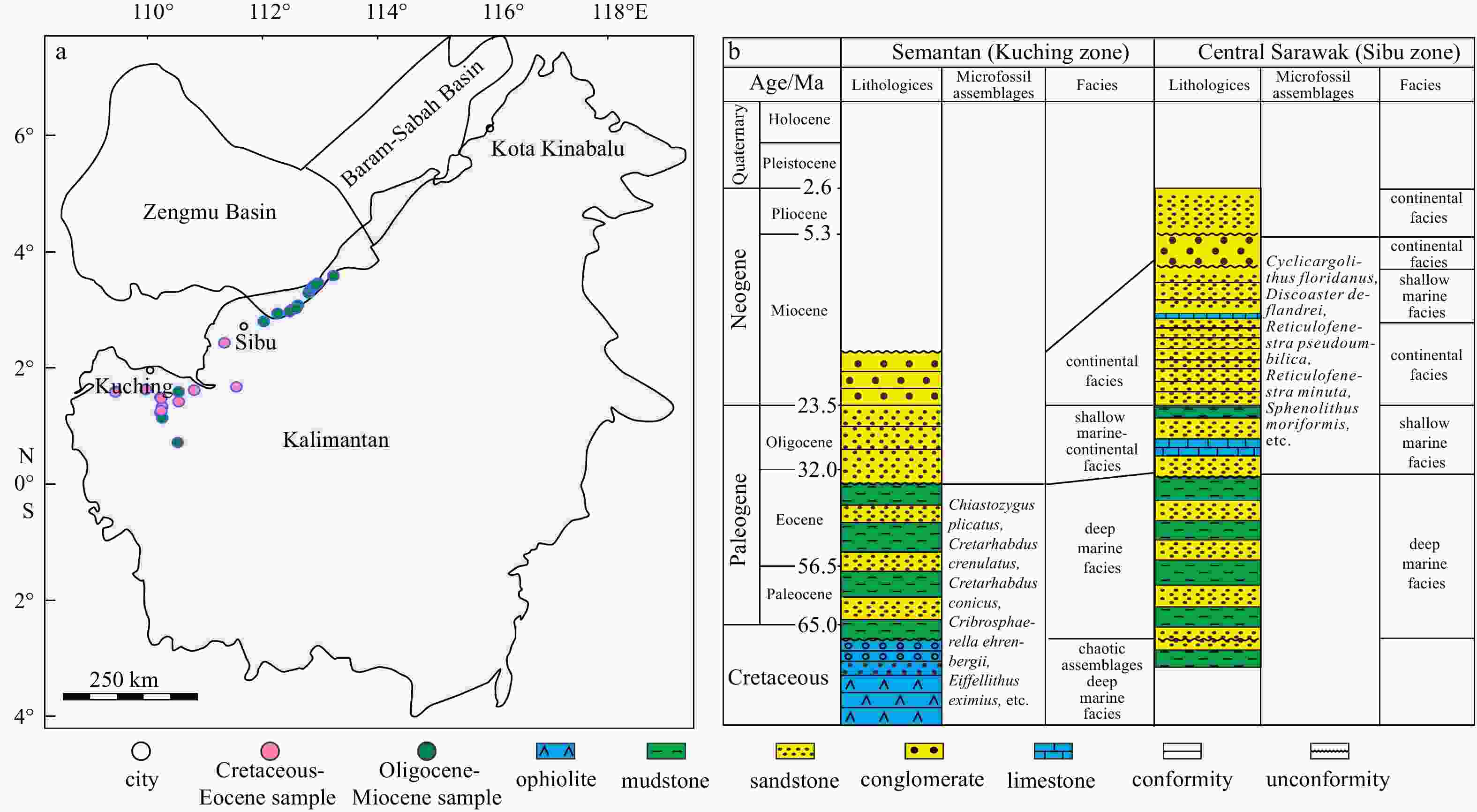
 下载:
下载:




